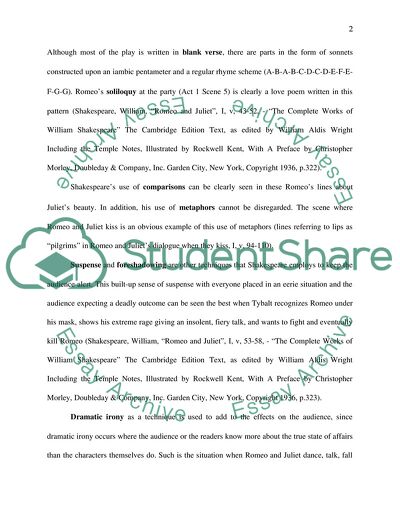
- Home
- Free Samples
- Premium Essays
- Editing Services
- Extra Tools
- Essay Writing Help
- About Us
- Studentshare
- Subjects
- Miscellaneous
- How does shakespeare use dramatic techniques in act 1 scene 5 of romeo and juliet what are the effects of these techniques on the audience
How does shakespeare use dramatic techniques in act 1 scene 5 of romeo and juliet what are the effects of these techniques on the audience - Essay Example

- Subject: Miscellaneous
- Type: Essay
- Level: Undergraduate
- Pages: 4 (1000 words)
- Downloads: 0
- Author: esperanza35
Extract of sample "How does shakespeare use dramatic techniques in act 1 scene 5 of romeo and juliet what are the effects of these techniques on the audience"
ornographic and sensible element in the speeches of the servants and the nurse, through the very cynical Mercutio to the noblest and most perfect one when both the body and soul join in everlasting delight. Shakespeare’s tragedy “Romeo and Juliet” (1595) shows his remarkable progress in building up characters. In “Romeo and Juliet” Shakespeare creates vivid characters observing and following them all through their process of spiritual growth and maturing, employing several dramatic techniques to be discussed here.
Shakespeare’s rich language and splendour lyrics characterise the whole play “not as much for the sake of functionality as they serve to profoundly describe sophisticated feelings and very often idealization of the characters” (Kogoj-Kapetanic, Breda & Vidan, Ivo, “English Literature” – “Engleska Knjizevnost”, Sveucilisna Naklada Liber, SNL, Zagreb, 1986, p.32). Although most of the play is written in blank verse, there are parts in the form of sonnets constructed upon an iambic pentameter and a regular rhyme scheme (A-B-A-B-C-D-C-D-E-F-E-F-G-G).
Romeo’s soliloquy at the party (Act 1 Scene 5) is clearly a love poem written in this pattern (Shakespeare, William, “Romeo and Juliet”, I, v, 43-52, - “The Complete Works of William Shakespeare” The Cambridge Edition Text, as edited by William Aldis Wright Including the Temple Notes, Illustrated by Rockwell Kent, With A Preface by Christopher Morley, Doubleday & Company, Inc. Garden City, New York, Copyright 1936, p.322). Shakespeare’s use of comparisons can be clearly seen in these Romeo’s lines about Juliet’s beauty.
In addition, his use of metaphors cannot be disregarded. The scene where Romeo and Juliet kiss is an obvious example of this use of metaphors (lines referring to lips as “pilgrims” in Romeo and Juliet’s dialogue when they kiss, I, v, 94-110). Suspense and foreshadowing are other techniques that Shakespeare employs to keep the audience alert. This
...Download file to see next pages Read MoreCHECK THESE SAMPLES OF How does shakespeare use dramatic techniques in act 1 scene 5 of romeo and juliet what are the effects of these techniques on the audience
Analyzing Cause and Effect: Antigone by Sophocles
Romeo and Juliet
Major Questions in the English Literature
The Sophie Dahls Opium Perfume Advertisement
Gone with the Wind vs Romeo and Juliet
How does Baz Luhrmann interpret Shakespeare's Romeo and Juliet
Acting and Theory of Drama
Relationship Between Drama and Theatre Education and Creative Learning

- TERMS & CONDITIONS
- PRIVACY POLICY
- COOKIES POLICY